MARYLAND - Maryland is famed for its dense forests, stunning beaches, and diversity of flora and fauna - from thick forests to beaches to over 90 mammal species, including black bears, which have become increasingly common across much of Maryland.
Maryland's Black Bear Boom: A Wildlife Success Story in the Old Line State
Maryland's black bear population is experiencing a remarkable resurgence, a testament to successful wildlife management and the adaptability of these impressive animals. Once scarce in the state, black bears are now thriving, with numbers reaching levels not seen in decades.
A Population on the Rise: More Bears Than Ever in Decades
The Maryland Department of Natural Resources (DNR) has reported a significant increase in black bear numbers.
- Population Estimate: Currently, there are estimated to be over 2,000 adult and subadult black bears roaming Maryland, primarily in the four western counties of Garrett, Allegany, Washington, and Frederick (Source: Maryland DNR). This represents a substantial increase and the highest population in at least 50 years.
- This is due to an increase in tolerance and improved habitats.
Western Maryland: The Heart of Bear Country
While black bears are expanding their range, western Maryland remains their stronghold.
- Ideal Habitat: The forested mountains and abundant food sources of Garrett, Allegany, Washington, and Frederick Counties provide perfect habitat for black bears.
- Food Sources: Black bears are omnivores, and their diet in Maryland includes acorns, hickory nuts, berries, insects, and other mast (the fruit of forest trees). The availability of these natural food sources contributes to the population's health and growth.
Expanding Range: Bears Beyond the Western Counties
While western Maryland is the core of the state's bear population, sightings are becoming more frequent in other areas.
- Increased Sightings: Reports of black bears have increased in counties beyond the traditional western range, including Baltimore County and the Washington D.C. metro areas.
- Young Males Dispersing: This expansion is often attributed to young male bears dispersing from their birth ranges in search of new territories and mates.
- Public Awareness: Recent bear encounters have prompted public awareness campaigns by the DNR and other agencies, educating residents on how to coexist safely with bears.
Living with Bears: Minimizing Conflict
As bear populations grow and their range expands, Maryland residents must understand how to coexist peacefully with these animals.
- Secure Food Sources: The most crucial step is to secure potential food sources that might attract bears to residential areas. This includes:
- Storing garbage in bear-resistant containers.
- Removing bird feeders during periods of bear activity.
- Keeping pet food indoors.
- Cleaning grills thoroughly after use.
- Encountering a Bear: If you encounter a bear, remain calm, do not approach it, and slowly back away while giving the bear a clear escape route. Report sightings to the Maryland DNR.
 Maryland's growing black bear population is a wildlife success story, a testament to the resilience of these animals and the effectiveness of conservation efforts. However, this success also brings challenges, as bears increasingly encounter human populations. By understanding bear behavior, taking precautions to minimize attractants, and supporting responsible wildlife management, Marylanders can coexist peacefully with these magnificent creatures, ensuring that black bears continue to thrive as a part of the state's natural heritage. The return of the black bear is a reminder of the importance of protecting and restoring wild habitats and a sign of a healthy ecosystem in Maryland.
Maryland's growing black bear population is a wildlife success story, a testament to the resilience of these animals and the effectiveness of conservation efforts. However, this success also brings challenges, as bears increasingly encounter human populations. By understanding bear behavior, taking precautions to minimize attractants, and supporting responsible wildlife management, Marylanders can coexist peacefully with these magnificent creatures, ensuring that black bears continue to thrive as a part of the state's natural heritage. The return of the black bear is a reminder of the importance of protecting and restoring wild habitats and a sign of a healthy ecosystem in Maryland.


